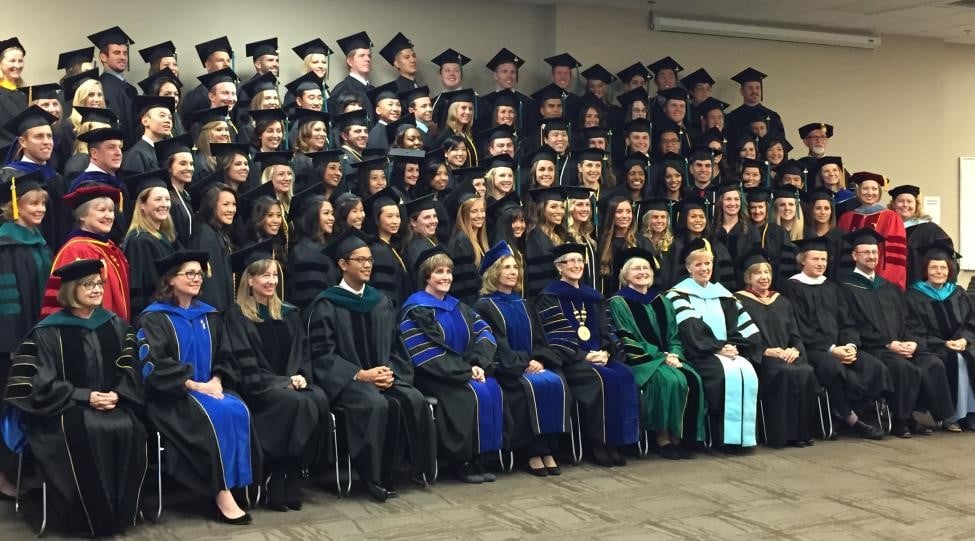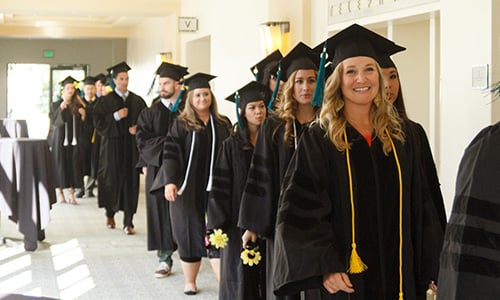
Graduate school is competitive. How can you make sure your application stands out from the rest?
We spoke to enrollment advisors (EAs) for our entry-level degree programs in physical therapy, occupational therapy, and speech-language pathology. They offered tips for how prospective students can navigate the application process and set themselves up for success.
A Customized Journey


Rebecca Thomason, EA, MS-SLP program
Rebecca Thomason, an EA dedicated to our Master of Science in Speech-Language Pathology (MS-SLP) program, says that the application process is customized for each person. “We meet with the prospective student early in the process, and we take the time to understand their current and future goals,” she says. “We begin with the end in mind and work backwards to establish a timeline for progressing to each next step on the application journey and completing any missing requirements within the due dates. We’re a resource to assist students submit a competitive application.”
For step-by-step instructions on applying to the program of your choice, check out our new How to Apply hub.
Preparing to Apply: Best Practices


Brianna Woods, EA, DPT program
Brianna Woods is an enrollment advisor for the Doctor of Physical Therapy (DPT) program on our San Marcos campus. “It’s great when students connect with us early in the process,” she says. “If we meet them when they’re still in undergrad—such as at a career fair—we can help them choose the right courses that will help with prerequisites.” She adds that it helps to earn your bachelor’s degree in a health sciences field so you can get a jump-start on your application timeline. Early in the process, she says, prospective students should focus on the following:
- Completing all needed prerequisites during undergrad.
- Keeping their grade point average (GPA) above 3.0, especially in prerequisite courses. (If needed, you may be able to raise your GPA by retaking one or more courses. USAHS will use the higher of the two grades.)
- Prepping for the GRE. PT applicants should aim for a 294 combined GRE score. Note that the GRE requirement is waived for our OT programs and is waived for the MS-SLP program in Fall 2022 and Spring 2023.
- Completing clinical observation hours as needed. (For OT applicants, starting in Fall 2022, clinical observation hours will no longer be required. However, they are strongly encouraged.)
- Lining up professional/academic contacts who are willing to write recommendation letters.
MS-SLP candidates who are entering speech from another field can take one or more of our MS-SLP leveling courses to earn the necessary prerequisites. Our EAs work with SLP applicants to create a customized, detailed plan for completing leveling courses before applying to graduate school.
Doing Your Homework
It’s a good idea to thoroughly research each school and program you want to apply to. This will help you ask the right questions of your enrollment advisor and put your effort into the programs that are the best fit for you.
- Explore the USAHS website and blog.
- Learn more about USAHS and the program of your choice by attending a webinar, virtual tour, or (best yet) an on-campus tour.
- Be sure you meet your program’s application requirements. Check out the requirements for your program of choice.
- Connect with an EA to strategize how to fill in any gaps. Admissions staff look at your whole application and handle situations on a case-by-case basis.
- Research how to apply through the Common Application System (CAS) that serves your program of interest (PTCAS, OTCAS, or CSDCAS). OT applicants may alternatively apply directly through USAHS’ online application.
Gathering the Documents
Woods says that once the prospective student is ready to meet with an EA, “then the conversation is about how the elements look and what they still need. There are many moving pieces, and the process is different for everyone.” This stage of the process involves:
- Gathering all the documents you need to apply: GRE score (if applicable), transcripts (showing all prerequisites needed), two letters of recommendation, résumé, and statement of purpose or writing sample. (See below for more about these.)
- Meeting with an EA to review the application components and any remaining items your application may need. Together, you will set goals and dates for completion. You will also discuss your needs—what you’re looking for in a program, what other schools you’re looking at and why, etc.
- Making sure you stay on top of all the due dates for submitting your application.
Statement of Purpose/Writing Sample: Best Practices
The statement of purpose/writing sample is a key element of every application. It’s a platform for you to share who you are and what brought you on your journey. Rather than just submitting a “form” statement, Woods advises, “Show that you know our program—and tell us why you’re interested in USAHS. This is a platform for you to share who you are, what sparked your interest in PT, any experiences you are drawing from, and what you are hoping to accomplish as a licensed clinician.”


Emma Roberts, EA, OT program
“It’s about your unique story and journey,” says Emma Roberts, enrollment advisor for our occupational therapy programs on the Dallas campus. She says that for OT candidates, it’s important to show why USAHS is a good fit and pinpoint specific experiences that inspired you to choose OT as your path. Along with the statement of purpose, the application for the MOT and OTD programs also include five supplemental questions. And beginning in Fall 2022, students applying to the Doctor of Occupational Therapy (OTD) program will complete an additional OTD-specific essay.
The Interview: Best Practices
The Admissions interview is held virtually, in a small group including two to three students. Roberts offers the following tips on the interview, based on prep sessions that she hosts. (Note that interviews are part of the admissions process for the PT and SLP programs, but will no longer be part of the OT application process as of Fall 2022.)
- Before the interview, double-check that your technology (audio, camera, Internet connection) is working well.
- Dress professionally.
- Come with questions; this shows you’re invested and engaged.
- Demonstrate good communication skills: listen to others and speak confidently when it’s your turn.
- Show how you will be a collaborative, team-oriented student in the classroom and colleague in the field.
- Highlight your time management skills and leadership abilities.
A Personalized, Rewarding Process
While other schools may not respond to every applicant, USAHS completes a personal review with the student of every application we receive. “We’re here for applicants every step of the way,” Woods says. “Reach out to us at any point in the process so we can steer you in the right direction.”
When asked what she finds most rewarding about her role as an EA, Roberts says, “When you work with an applicant for months and they’re not very competitive at first, but you help them get their GPA higher and get more shadowing experience—that’s what I love. You’re watching the journey from start to finish, and then you get to be the person who called them to congratulate them and see their excitement that their hard work has paid off!”








